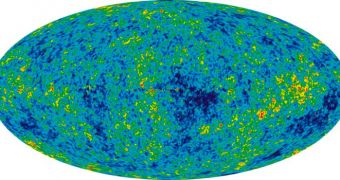A team of investigators from the US Department of Energy's Fermi National Accelerator Laboratory (Fermilab) Center for Particle Astrophysics (CPA) says that dark matter is the most improbable ally that life has in its struggle to spread across the Universe.
Two researchers say that the stuff – which cannot be detected directly with current technology – provides the heat needed for life to thrive in planets that are not necessarily located inside their parent stars' habitability zones.
These so-called Goldilocks areas are regions of space around a star where temperature ranges are correct for supporting life. Earth is located right in the middle of the Sun's habitable zone, with Venus and Mars touching in on the region's inner and outer boundaries.
Physicists Dan Hooper and Jason Steffen argue that dark matter particles in dense clouds could literally penetrate the surface of an exoplanet, and reach all the way into its core. At that location, the particles would interact with materials in the core, and the process would eliminate a lot of heat.
Through this mechanism, investigators say, it may become possible for planets that are not necessarily located in the habitability zone to support liquid water. The latter is a prerequisite condition for the development of life as we know it.
Current understanding of dark matter dictates that the stuff is made up of weakly-interacting massive particles (WIMP), which annihilate each other if they touch. They do not interact with normal, baryonic matter either, but make their effects known through the force of gravity.
“The reason we don't see dark matter directly is that it is made up of very weakly interacting material. For that reason, it doesn't interact – or do much of anything else – very much. It’s basically inert, and thus doesn't produce much usable energy,” Hooper explains.
The expert is the lead author of a new paper detailing the results of the study. The work, entitled “Dark Matter and the Habitability of Planets,” was already submitted to the Astrophysical Journal, for publication in an upcoming issue, Space reports.
“If a dark matter particle passes through a planet, there is a chance that it will collide with an atom and lose some of its speed and momentum,” Hooper goes on to say. He adds that dark matter may be of most use in areas that are either at the core or outer reaches of galaxies.
“Once this happens, instead of just flying off into space again, it can be stuck to the planet by the force of gravity and once that happens, it does not take very long for the dark matter particle to fall into the core of the planet, where it will stay,” he adds.
The new investigation also carries some interesting implication on the types of lifeforms we may encounter on exoplanets fueled by dark matter.
“Life on a planet heated by dark matter would likely be very different than the life on Earth. Many species of planets on Earth, for example, have evolved to collect energy from sunlight,” Hooper says.
“On a dark-matter-powered planet, the energy would be coming from the center of the planet, and life there would have to find other ways of putting that energy to use,” he concludes.

 14 DAY TRIAL //
14 DAY TRIAL //